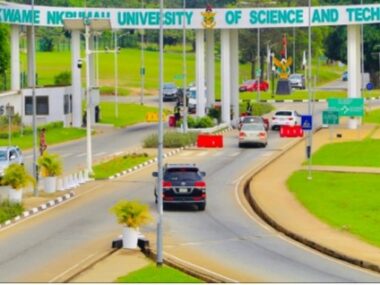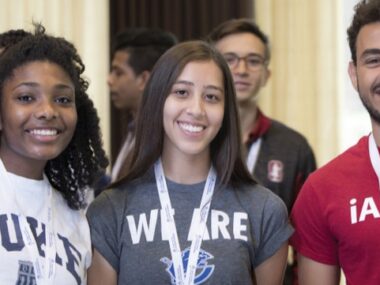University of Education Winneba Past Questions – Communication Skills
1. One of the ladies …. Reported to the school authorities.
(A) Has been
(B) Have been
(C) Has being
(D) have being
2. The boys’ washroom …. Left untidy.
(A) Have been
(B) Has being
(C) Were
(D) Was
3. Nobody, except the footballers … allowed to enter the stadium.
(A) Was
(B) were
(C) have been
(D) were being
4. All the security men on duty, with the exception of Mr. Sam… given awards.
(A) Has been
(B) is
(C) were
(D) have being
5. The various parts of the human body … extensively studied.
(A) Has been
(B) have been
(C) have being
(D) is being
6. Our Officer in charge of public relation … a letter to the office.
(A) Have written
(B) has written
(C) has wrote
(D) have write
7. In front of the procession … the Vice Chancellor and the Registrar.
(A) Was
(B) were
(C) is
(D) has been
8. The tuber, together with the medication… given to the patient.
(A) Was
(B) were
(C) has being
(D) have been
9. Either our sister or the driver … them to school on rainy days.
(A) Drives
(B) drive
(C) were driven
(D) have driven
10. The proprietor and the manager of the company… assaulted a certain woman.
(A) Has
(B) have
(C) was
(D) had been
11. AIDS; FDB; ECOWAS are examples of …
(A) Abbreviations
(B) Acronyms
(C) Mnemonics
(D) Symbols
12. The graphic organizer used to show the difference and similarities between two concepts is
(A) Contrast box
(B) Concept map
(C) Venn diagram
(D) Semantic web
13. Identify the odd out
(A) Quotation
(B) Summary
(C) Hierarchical Array
(D) Paraphrase
14. … Involves the arrangement of ideas according to their various parts and the relationship between these parts.
(A) Outline
(B) Spidergram
(C) Contrast box
(D) Paraphrase
15. Language interference is also known as …
(A) Linguistique barrier
(B) Linguistic barrier
(C) Linguistical barrier
(D) Linguist barrier
16. In the SQ5R studying technique, when we first glance through a material/ note or text to get an overall view, this is known as
(A) review
(B) survey
(C) recall
(D) skimming
17. This is not a graphic organizer
(A) Sequence of chains
(B) Cluster diagrams
(C) Linear array
(D) Contrast effect
18. These are the rules for running study groups except
(A) Arrive on time for meeting
(B) Prepare well and perform task adequately
(C) Interrupt others when they are speaking
19. If John is reading the book titled “Things Fall Apart” as part of his preparation towards his Literature in English exam, this type of reading could be classified as
(A) Wide reading
(B) close reading
(C) extensive reading
(D) scan reading
20. The … reduces the whole passage to only a couple of words.
(A) Headline technique
(B) graphic organizer
(C) linear array
(D) paraphrase
21. To help reduce your writing load when taking notes, you may use
(A) repetitions
(B) synonyms
(C) acronyms
(D) hyponyms
22. A note Is useful to a student because it
(A) serves as evidence of progress
(B) reduces stress level
(C) does not waste time
(D) makes you more active listener
23. The … is used to show the order of importance of a number of concepts or items.
(A) Outline
(B) concept map
(C) hierarchical array
(D) linear array
24. The advantage diagrammatic notes have over diagrammatic notes is that with diagrammatic notes
(A) there is no repetition
(B) one can see the main points at a glance
(C) the main points are underlined
(D) you can get enough paragraphs on one page
25. ..… are special diagrammatic notes used to organize information to show the relationship between ideas in a picture form
(A) Graphic organizers
(B) Patterned notes
(C) Quotations
(D) Reduction techniques
26. Kwame is looking up a word in a dictionary. We can say he is
(A) skimming
(B) doing intensive reading
(C) scanning
(D) doing research
27. When a student is using SQ5R studying Technique, Recall involves
(A) thinking about what is read
(B) reading your note well
(C) reciting key points from memory
(D) changing sub-heading into questions
28. This is a reading fault when one reads a portion that has already been read due to lack of concentration
(A) regression
(B) vocalization
(C) sub-vocalization
(D) fixation
29. The final stage of the SQ5R studying technique involves
(A) revisiting the material studied again later, after some time
(B) reciting the important points
(C) think about how the new information connects with what you already know
(D) write down what you need to remember
30. one of the advantages of extensive reading Is that it
(A) helps us to perform well in exams
(B) Improves our reading skill
(C) reduces fatigue
(D) broadens our horizon.
31. Identify formal language suitable for academic writing.
a. The officials weren’t willing to disclose the source of the information
b. Twenty participants couldn’t respond to the questionnaire
c. It’s a long process to carry out a longitudinal study
d. First, identify the variables to be investigated
32. .An abstract usually starts with an introduction, and indicates the …. of the study.
a. conclusion or recommendation
b. literature review
c. Purpose or objectives
d. appendix or attachment
33. A close distance between two communicators may communicate
a. loyalty
b. mistrust
c. disgust
d. intimacy
34. The two receptive skills are
a. Speaking and Writing
b. Listening and Writing
c. Listening and Reading
d. Reading and Speaking
35. The Department of Political Science in the university could be a smaller discourse community
a. None is true
b. False
c. True
d. Both are true
36. Any communication that conveys a message consisting of words is called
a. Non-verbal communication.
b. Verbal communication.
c. Written communication.
d. Oral communication.
37. Academic writings are composed by consulting multiple sources
a. False
b. Both may be true
c. True
d. Not multiple but single
38. Identify the ODD one out
a. Formality in tone
b. Preference for passive voice
c. Defined structure
d. Broad common goals
39. A certain look or glance is an example of
a. Non-verbal communication
b. Written communication.
c. Verbal communication.
d. Oral communication.
40. The behaviour exhibited by the destination in communication is referred to as
a. effective communication
b. receiver
c. feedback
d. a code
41. Identify formal language suitable for academic writing.
a. The right model wasn’t used to analyse the data
b. It is ok for a child to rely on his dad for support
c. Wornyo (2019) argues that local languages aren’t good for instruction
d. Some of the claims made by the researcher are debatable
42. Which of the following is a genre that is used to communicate among researchers in the academia?
a. white papers
b. application letters
c. documentaries
d. review articles
43. Which of the following parts of a project work or long essay, provides background of the study? a. List of tables
b. Conclusion
c. Findings
d. Introduction
44. The scholar credited with the founding of the discipline of Discourse Communities is known as … a. Joseph Swales
b. Jim Swales
c. John Swales
d. Jordan Swal
45. A boy is so fond of a puppy that he keeps touching it often. This is
a. chronemics
b. haptics
c. oculesics
d. objectics
46. An interaction between a lecturer and a student that results in exchange of ideas is
a. monolineal intrapersonal communication
b. bilineal public communication
c. bilineal interpersonal communication
d. monolineal interpersonal communication
47. Identify formal language suitable for academic writing.
a. That’s the way forward for politicians
b. We won’t permit wrong things to be done
c. Some writers have questioned the methodology used
d. This can’t be altered for the analysis
48. Discourse communities use one or more genres to communicate among their members.
a. This is usually the case
b. There is nothing like genres
c. All these are not possible
d. It does not happen
49. Feedbacks are termed unintended when responses are
a. Not expected
b. Expected
c. Accepted
d. Not Rejected
50. A student who is checking information on the notice board is using
a. a basic language skill
b. a secondary language skill
c. a tertiary language skill
d. a primary language skill
51. Which of the following is not a medium of transmission?
a. memos
b. planned exercise
c. discussions
d. policy statements





